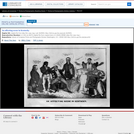A racist attack on Democratic vice-presidential candidate Richard M. Johnson. The Kentucky Congressman's nomination, in May 1835, as Van Buren's running-mate for the 1836 election raised eyebrows even among party faithful, because of Johnson's common-law marriage to a mulatto woman, Julia Chinn, by whom he fathered two daughters. The artist ridicules Johnson's domestic situation, and the Democrats' constituency as well. Seated in a chair with his hand over his face, a visibly distraught Johnson lets a copy of James Watson Webb's "New York Courier and Enquirer" fall to the floor and moans, "When I read the scurrilous attacks in the Newspapers on the Mother of my Children, pardon me, my friends if I give way to feelings!!! My dear Girls, bring me your Mother's picture, that I may show it to my friends here." On the right are his two daughters, Adaline and Imogene, wearing elegant evening dresses. One presents a painting of a black woman wearing a turban, and says, "Here it is Pa, but don't take on so." The second daughter says, "Poor dear Pa, how much he is affected." A man behind them exclaims, "Pickle! Pop!! and Ginger!!! Can the slayer of Tecumseh be thus overcome like a summer cloud! fire and furies. oh!" Johnson is reported to have slain the Indian chief Tecumseh. Flanking Johnson are a gaunt abolitionist (right) and a black man. The abolitionist holds a copy of the "Emancipator," a Hartford, Connecticut newspaper, and says, "Be comforted Richard; all of us abolitionists will support thee." The black man pledges, ". . . de honor of a Gentlemen dat all de Gentlemen of Colour will support you." On the far left is a stout postmaster who says, "Your Excellency, I am sure all of us Postmasters and deputies will stick to you; if you promise to keep us in office." The print seems to date from early in the campaign of 1836. Johnson's wife Julia Chinn died in 1833. Adaline, one of the two daughters pictured, died in February 1836. Although Weitenkampf dates the print at 1840, when Johnson was again Van Buren's running-mate, the presence of both daughters and the drawing style are persuasive evidence for an 1836 date.|Probably published by Henry R. Robinson, New York.|Title appears as it is written on the item.|Weitenkampf, p. 63.|Forms part of: American cartoon print filing series (Library of Congress)|Published in: American political prints, 1766-1876 / Bernard F. Reilly. Boston : G.K. Hall, 1991, entry 1836-15.



















